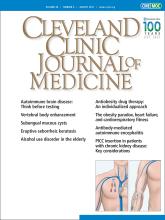Article Figures & Data
Tables
Greater metabolic reserves Less cardiac cachexia Increased concentration of tumor necrosis factor receptors Earlier presentation owing to greater functional impairment Attenuated response to renin-angiotensin-aldosterone system Higher blood pressure leading to greater use of cardioprotective medications Adapted from reference 6.
- TABLE 2
Studies assessing BMI and cardiorespiratory fitness: Effect on heart failure development
Study N Designa End point Main findings Pandey et al19 Cooper Center Longitudinal Study 19,485 Patients stratified by BMI and peak METs into quintiles Long-term risk of hospitalization for HF Higher midlife BMI was significantly associated with greater risk of hospitalization for HF in older age. This association was attenuated after adjusting for cardiorespiratory fitness. Kenchaiah et al20 Physicians’ Health Study 21,094 Patients stratified by BMI and vigorous physical activity New onset HF Compared with lean participants, overweight and obese participants had increased HF risk. Vigorous physical activity conferred decreased HF risk. No interaction was found between BMI, vigorous physical activity, and HF risk. Hu et al21 59,178 Patients stratified by physical activity and indicators of adiposity (eg, BMI, waist circumference, waist-to-hip ratio) New onset HF Higher BMI, waist circumference, or waist-to-hip ratio was associated with increased HF incidence in men and women. The protective effect of physical activity on HF risk was consistent in participants at all levels of BMI. Kokkinos et al22 20,254 Patients stratified by BMI and cardiorespiratory fitness in quartiles New onset HF Increased cardiorespiratory fitness was associated with progressively lower HF risk regardless of BMI. After adjusting for fitness, BMI was not a significant predictor of HF risk. Pandey et al23 Look AHEAD trial 5,109 (with DM) Patients stratified by BMI and cardiorespiratory fitness into tertiles New onset HF High cardiorespiratory fitness was associated with lower risk of developing HFpEF. Sustained long-term improvement in fitness was associated with lower risk of HF after 4 years. ↵a All studies are retrospective.
AHEAD = Action for Health in Diabetes; BMI = body mass index; DM = diabetes mellitus; HF = heart failure; HFpEF = heart failure with preserved ejection fraction; METs = metabolic equivalents
- TABLE 3
Studies assessing BMI and cardiorespiratory fitness: Effect on heart failure prognosis
Study Na Average LVEF of target groups Designb End point Main findings Lavie et al24 2,066 High fit = 30.1%
Low fit = 26.0%Patients stratified by BMI and peak VO2 Overall mortality In patients with low cardiorespiratory fitness, BMI ≥ 30 kg/m2 was a significant predictor of better survival. No obesity paradox seen at the high fitness level. Clark et al7 1,675 High fit = 23.4%
Low fit = 23.2%Patients stratified by BMI and peak VO2 Death, urgent status 1A heart transplant, or VAD placement. BMI of obesity class was associated with a significantly lower risk of death, urgent transplant, or device placement than with normal BMI in the group with low peak VO2. In the high peak VO2 group, no difference was seen for BMI and survival. Piepoli et al27 MECKI Score Research Group 4,623 BMI (kg/m2) < 25 = 31%
25 to 30 = 33%
> 30 to ≤ 35 = 33%
> 35 = 33%Patients stratified by BMI and peak VO2 All-cause mortality and CV death Higher BMI and peak VO2 were significant positive predictors of longer survival. When patients in a BMI category were matched according to age, sex, LVEF, and peak VO2, the protective role of BMI disappeared. McAuley et al26 FIT Project 774 High fit = 41%
Low fit = 40%Patients stratified by BMI and peak METs Overall mortality Significant positive association between BMI category and survival for exercise capacity < 4 METs, but not ≥ 4 METs. ↵a All patients had established heart failure.
↵b All studies were retrospective.
BMI = body mass index; CV = cardiovascular; FIT = Henry Ford Exercise Testing; LVEF = left ventricular ejection fraction; MECKI = Metabolic Exercise test data combined with Cardiac and Kidney Indexes; METs = metabolic equivalents; VAD = ventricular assist device; VO2 = exercise oxygen uptake
Setting Established study findings Current limitations Research questions Patients with heart failure BMI appears to be protective predominantly in patients with low fitness. Different obesity classes have not been specifically evaluated.
No separate evaluation of patients with either preserved or mid-range ejection fraction; they are largely grouped with reduced ejection fraction.Is cardiorespiratory fitness an obesity paradox modifier in specific classes of obesity?
Is cardiorespiratory fitness an obesity paradox modifier in HFpEF and HFmrEF?Heart failure prevention Improving cardiorespiratory fitness may be more important for risk reduction than lowering BMI.
In patients with established diabetes, improved fitness may decrease the risk of developing HFpEF.
Increasing BMI and specific measures of adiposity correlate with increased risk of developing heart failure.
Even small amounts of physical activity decrease risk of developing heart failure.
Physical activity appears to have a dose-dependent effect on heart failure risk, with the lowest risk associated with highest frequency of physical activity.No differentiation between types or duration of physical activity.
Limited specificity of type of heart failure as end point (ie, HFpEF, HFmrEF, or HFrEF).
Women underrepresented.What type of physical activity leads to the lowest risk of heart failure development?
How do BMI and cardiorespiratory fitness (and interventions) affect development of different types of heart failure?
Are findings relevant for women?Weight loss Either surgical or lifestyle-based weight loss may reduce morbidity from heart failure.
Unintentional weight loss indicates acute illness and contributes to poor metabolic reserve, leading to worse outcomes.Lack of clinical outcomes data after intentional weight loss for patients with heart failure and obesity.
Limited data on specific exercise training programs in heart failure outcomes or prevention.How does medical vs surgical weight loss affect heart failure morbidity and mortality rates, particularly with newer medical therapies for obesity?
How does supervised exercise for patients with heart failure and obesity affect fitness, weight loss, and outcomes?BMI = body mass index; HFmrEF = heart failure with mid-range ejection fraction; HFpEF = heart failure with preserved ejection fraction; HFrEF = heart failure with reduced ejection fraction






